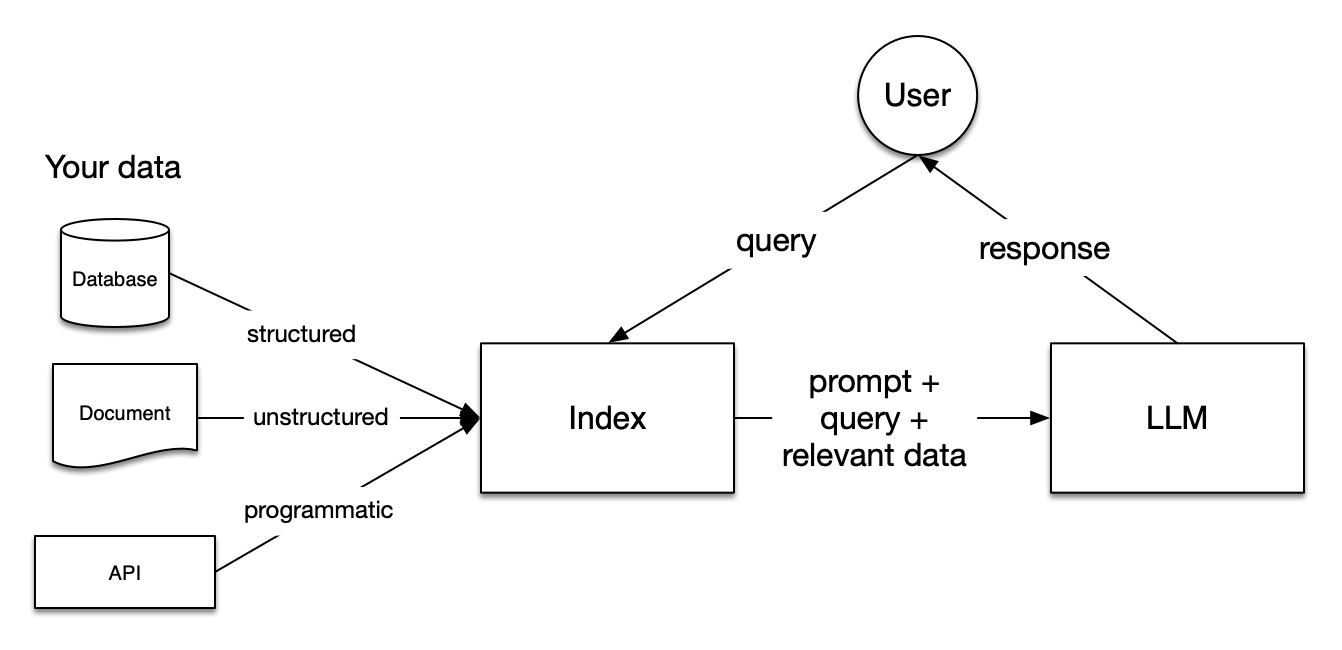High-Level Concepts (RAG)#
This is a quick guide to the high-level concepts you'll encounter frequently when building LLM applications.
Tip
If you haven't, install LlamaIndex and complete the starter tutorial before you read this. It will help ground these steps in your experience.
Retrieval Augmented Generation (RAG)#
LLMs are trained on enormous bodies of data but they aren't trained on your data. Retrieval-Augmented Generation (RAG) solves this problem by adding your data to the data LLMs already have access to. You will see references to RAG frequently in this documentation.
In RAG, your data is loaded and prepared for queries or "indexed". User queries act on the index, which filters your data down to the most relevant context. This context and your query then go to the LLM along with a prompt, and the LLM provides a response.
Even if what you're building is a chatbot or an agent, you'll want to know RAG techniques for getting data into your application.

Stages within RAG#
There are five key stages within RAG, which in turn will be a part of any larger application you build. These are:
-
Loading: this refers to getting your data from where it lives -- whether it's text files, PDFs, another website, a database, or an API -- into your pipeline. LlamaHub provides hundreds of connectors to choose from.
-
Indexing: this means creating a data structure that allows for querying the data. For LLMs this nearly always means creating
vector embeddings, numerical representations of the meaning of your data, as well as numerous other metadata strategies to make it easy to accurately find contextually relevant data. -
Storing: once your data is indexed you will almost always want to store your index, as well as other metadata, to avoid having to re-index it.
-
Querying: for any given indexing strategy there are many ways you can utilize LLMs and LlamaIndex data structures to query, including sub-queries, multi-step queries and hybrid strategies.
-
Evaluation: a critical step in any pipeline is checking how effective it is relative to other strategies, or when you make changes. Evaluation provides objective measures of how accurate, faithful and fast your responses to queries are.

Important concepts within each step#
There are also some terms you'll encounter that refer to steps within each of these stages.
Loading stage#
Nodes and Documents: A Document is a container around any data source - for instance, a PDF, an API output, or retrieve data from a database. A Node is the atomic unit of data in LlamaIndex and represents a "chunk" of a source Document. Nodes have metadata that relate them to the document they are in and to other nodes.
Connectors:
A data connector (often called a Reader) ingests data from different data sources and data formats into Documents and Nodes.
Indexing Stage#
Indexes:
Once you've ingested your data, LlamaIndex will help you index the data into a structure that's easy to retrieve. This usually involves generating vector embeddings which are stored in a specialized database called a vector store. Indexes can also store a variety of metadata about your data.
Embeddings LLMs generate numerical representations of data called embeddings. When filtering your data for relevance, LlamaIndex will convert queries into embeddings, and your vector store will find data that is numerically similar to the embedding of your query.
Querying Stage#
Retrievers: A retriever defines how to efficiently retrieve relevant context from an index when given a query. Your retrieval strategy is key to the relevancy of the data retrieved and the efficiency with which it's done.
Routers:
A router determines which retriever will be used to retrieve relevant context from the knowledge base. More specifically, the RouterRetriever class, is responsible for selecting one or multiple candidate retrievers to execute a query. They use a selector to choose the best option based on each candidate's metadata and the query.
Node Postprocessors: A node postprocessor takes in a set of retrieved nodes and applies transformations, filtering, or re-ranking logic to them.
Response Synthesizers: A response synthesizer generates a response from an LLM, using a user query and a given set of retrieved text chunks.
Putting it all together#
There are endless use cases for data-backed LLM applications but they can be roughly grouped into three categories:
Query Engines: A query engine is an end-to-end pipeline that allows you to ask questions over your data. It takes in a natural language query, and returns a response, along with reference context retrieved and passed to the LLM.
Chat Engines: A chat engine is an end-to-end pipeline for having a conversation with your data (multiple back-and-forth instead of a single question-and-answer).
Agents: An agent is an automated decision-maker powered by an LLM that interacts with the world via a set of tools. Agents can take an arbitrary number of steps to complete a given task, dynamically deciding on the best course of action rather than following pre-determined steps. This gives it additional flexibility to tackle more complex tasks.
Tip
- Tell me how to customize things
- Continue learning with our understanding LlamaIndex guide
- Ready to dig deep? Check out the component guides